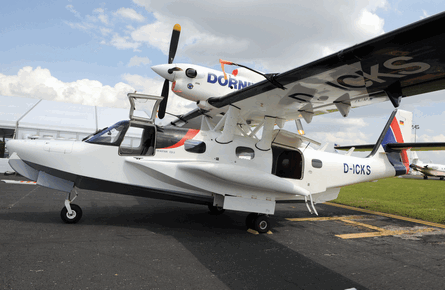The Dornier Seaplane Company (Booth 1040) announced Monday a plan to revive production of the Seastar seaplane – and this time it’ll be built in the US.
The Seastar first flew in 1984, and three examples were built in Germany before production ended in 1991. A 1990s plan for volume manufacture in Malaysia fell through, but the German Dornier family now plans to restart production within the next two years.
“We are continuing what my grandfather started back in 1910,” says Conrado Dornier, grandson of Claude Dornier. The Dornier family has invested $150 million in the project. “It's wholly owned by my family,” Conrado Dornier says. “It is totally independent of all other Dornier Aircraft businesses, which are owned by EADS, with us as a shareholder.”
One of the original Seastars is in the static park, and a cabin mock-up is at the Dornier booth. It is the first time the airplane has visited the US. The composite 12-seat aircraft is powered by twin Pratt & Whitney PT6A-135As, set together above the wing in a pusher/puller configuration. CEO Joe Walker lists the corrosion-proof composites and custom design among its merits. “Because it's a flying boat and not a boat-modified airplane, it’s one of the fastest seaplanes out there at 180kt,” he says.
 |
|---|
The US production site will be announced soon, though fabrication is being outsourced. Most suppliers are American, Walker says, and the favorable exchange rate supports this launch.
He expects to find a niche among private owner, as well as airlines and search and rescue operators. Deposits are being taken now with an incentive price of $5.5m for the first ten and $6m for subsequent airframes after.
Improvements to the 20-year-old design will follow, including an autopilot to allow single-pilot operation. “We'd like to build one airplane 24 months from now,” Walker says. Production could ramp up to 48 per year by 2015 to join the 500 turbine seaplanes already around the world. But the immediate issue is more basic: “We've got to translate all the drawings from German to English,” he says.
Source: Flight Daily News
















